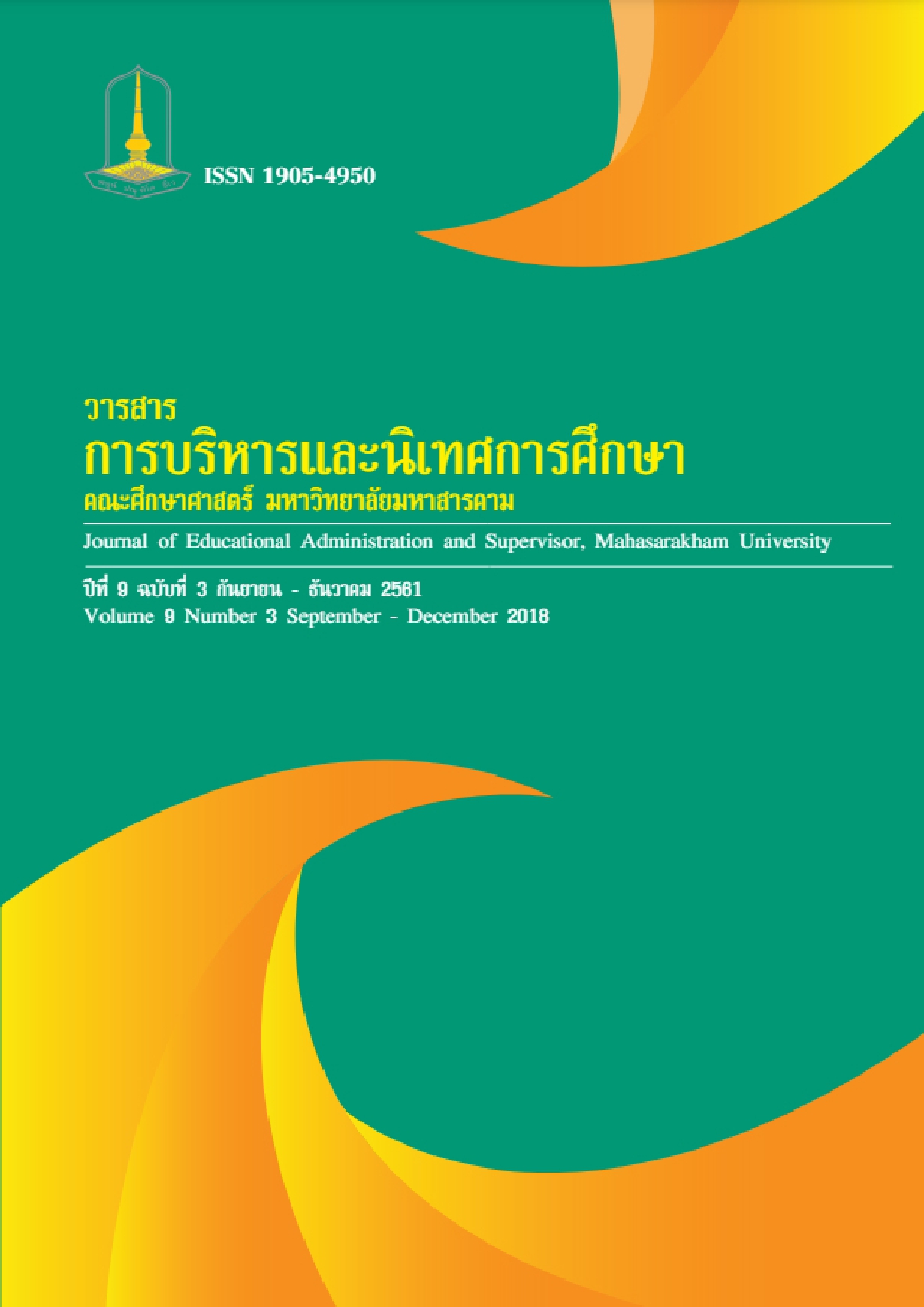A Study of Learning Achievement and Critical Thinking in Thai History of Mathayom Suksa 4 Using Historical Methodology with Mind Map Technique
Main Article Content
Abstract
The objective of the research were 1) to development the lesson plans using Historical Methodology with Mind map Technique in the Thai ancient and the states in Thailand unit, on the efficiency of 80/80. 2) To observe the effectiveness index of the lesson plans Historical Methodology with Mind Technique. 3) to study Mathayom Suksa 4 student’s learning achievement in Thai History by using Historical Methodology with Mind Map Technique in which 70% of the students were expected to pass the prescribed learning achievement criterion of 80% or better and 4) to study the student’s critical thinking in witch 70% of them were expected to pass the prescribed criterion of 80% or better. The sample used in this research consisted of 35 Mathayom Suksa 4/4 Students of Mahasarakham University Demonstrction School (Secondary), Kantharawichai, Maha Sarakham, in the First semester
of the academic year 2017. The obtaining was the cluster random sampling technique. Three type of instruments used in the research were: 5 lesson plans, taught for 10 hours; a 30 items 4 choice achievement test with discriminating power ranging 0.40-0.68, and a reliability of 0.89; a 30 items 4 choice critical thinking test with discriminating power ranging 0.28-0.91, and a reliability of 0.87, The statistics used for analyzing the collected data were percentage, mean, and standard deviation.
Downloads
Article Details
References
กระทรวงศึกษาธิการ. (2542). คำชี้แจงประกอบพระราชบัญญัติการศึกษาแห่งชาติ. กรุงเทพฯ: โรงพิมพ์กรมศาสนา.
กระทรวงศึกษาธิการ. (2551). หลักสูตรแกนกลาง พุทธศักราช 2551. กรุงเทพฯ: โรงพิมพ์ชุมนุสหกรณ์การเกษตรแห่งประเทศไทย จำกัด.
ทิศนา แขมมณี และคณะ. (2544). วิทยาการด้านการคิด. กรุงเทพฯ: สถาบันพัฒนาคุณภาพวิชาการ.
ศันสนีย์ ฉัตรคุปต์ และอุษา ชูชาติ. (2545). ฝึกสมองให้คิดอย่างมีวิจารณญาณ. พิมพ์ครั้งที่ 2. มหาสารคาม: วัฒนพานิช.
สมชาย วิริจินดา. (2553). การเปรียบเทียบผลสัมฤทธิ์ทางการเรียนสาระประวัติศาสตร์และความพึงพอใจของนักเรียนชั้นมัธยมศึกษาปีที่ 6 ระหว่างการจัดกิจกรรมการเรียนรู้โดยใช้วิธีการแบบโครงงานกับวิธีการทางประวัติศาสตร์. วิทยานิพนธ์ครุศาสตรมหาบัณฑิต สาขาวิชาหลักสูตรและการสอน มหาวิทยาลัยราชภัฏมหาสารคาม.
สมบูรณ์ คนขยัน. (2555). การเปรียบเทียบผลสัมฤทธิ์ทางการเรียนและความสามารถในการคิดอย่างมีวิจารณญาณ เรื่องประวัติศาสตร์สมัยสุโขมัย กลุ่มสาระการเรียนรู้สังคมศึกษา ศาสนา และวัฒนธรรม ของนักเรียนชั้นประถมศึกษาปีที่ 4 ระหว่างการเรียนบนเว็บด้วยวิธีการทางประวัติศาสตร์และวิธีการเรียนแบบปกติ. วิทยานิพนธ์ปริญญาการศึกษามหาบัณฑิต สาขาวิชาเทคโนโลยีการศึกษา มหาวิทยาลัยมหาสารคาม.
เสน่ห์ ฉวยกระโทก. (2556). การศึกษาผลสัมฤทธิ์ทางการเรียน หน่วยการเรียนรู้ประวัติศาสตร์รัตนโกสินทร์และความสามารถในการคิดวิเคราะห์ของนักเรียนชั้นมัธยมศึกษาปีที่ 4 จากการใช้วิธีการทางประวัติศาสตร์ร่วมกับผังความคิด. วิทยานิพนธ์ครุศาสตรมหาบัณฑิต. มหาวิทยาลัยราชภัฏนครราชสีมา.
อนุพงษ์ ชุมแวงวาปี. (2554). ผลการใช้หน่วยการเรียนรู้แบบย้อนกลับ (Backward Design) โดยใช้การสอนด้วยวิธีการทางประวัติศาสตร์ต่อการคิดอย่างมีวิจารณญาณ ของนักเรียนชั้นมัธยมศึกษาปีที่ 4. วิทยานิพนธ์ปริญญาศึกษาศาสตรมหาบัณฑิต สาขาวิชาหลักสูตรและการสอน มหาวิทยาลัยขอนแก่น.
อัครเดช แสนณรงค์. (2557). การศึกษาผลสัมฤทธิ์ทางการเรียนและการคิดอย่างมีวิจารณญาณ รายวิชา ส31102 ประวัติศาสตร์ของนักเรียนชั้นมัธยมศึกษาปีที่ 4 โดยใช้การสอนด้วยวิธีการทางประวัติศาสตร์ร่วมกับเทคนิคผังกราฟิก. วิทยานิพนธ์ปริญญาศึกษาศาสตรมหาบัณฑิต สาขาวิชาหลักสูตรและการสอน มหาวิทยาลัยขอนแก่น.


